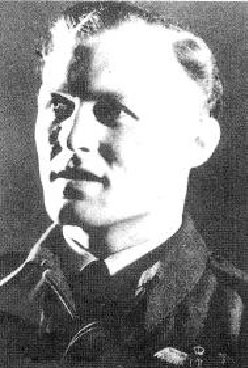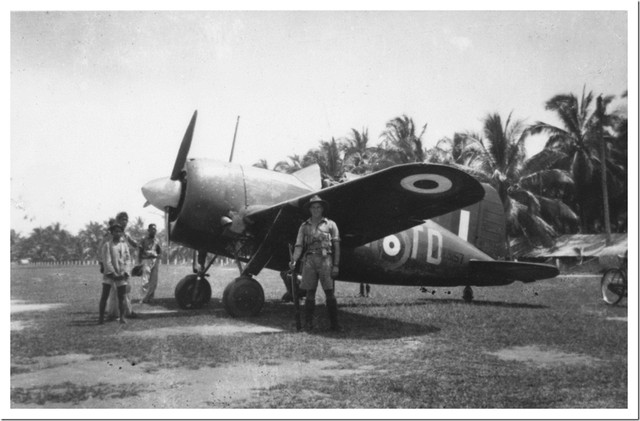 Author’s note:
Author’s note:
This fragment is based upon the experiences of Flight-Lieutenant Tim Vigors DFC, who was acting CO of No. 453 Sqn RAAF from December 1 until December 13, 1941. Vigors was educated at Eton and joined the RAF in 1939. He flew with 222 Sqn during the battle of Britain and was credited with 9 ½ “Kills” for which he was awarded the DFC in October 1940. Interesting detail: Douglas Bader, the legless RAF pilot, was in the same squadron at Hornchurch. When they flew night-time sorties, Vigors had to attach Bader’s wooden left leg.
 In December 1940, Vigors was transferred to Singapore as a flight leader with 243 Sqn RAF. Early December 1941, he was appointed acting CO of 453 Sqn RAAF. The squadron was first tasked with fleet protection but, after the Japanese invaded north-western Malaya, transferred to Butterworth in an effort to stem the tide of the Japanese advance. A six ship element of 453 Sqn arrived at Butterworth on December 13, 1941 and was almost immediately caught in a Japanese air raid. Vigors managed to scramble his Buffalo but he soon was hit in his leg and petrol tank. He bailed out of his burning fighter and was machine-gunned by Japanese fighters all the way down. Badly burned and with a bullet wound in his thigh, Vigors spent a night on top of a hill. He was found by two Malays and carried back (on a bicycle) to the airfield.
In December 1940, Vigors was transferred to Singapore as a flight leader with 243 Sqn RAF. Early December 1941, he was appointed acting CO of 453 Sqn RAAF. The squadron was first tasked with fleet protection but, after the Japanese invaded north-western Malaya, transferred to Butterworth in an effort to stem the tide of the Japanese advance. A six ship element of 453 Sqn arrived at Butterworth on December 13, 1941 and was almost immediately caught in a Japanese air raid. Vigors managed to scramble his Buffalo but he soon was hit in his leg and petrol tank. He bailed out of his burning fighter and was machine-gunned by Japanese fighters all the way down. Badly burned and with a bullet wound in his thigh, Vigors spent a night on top of a hill. He was found by two Malays and carried back (on a bicycle) to the airfield.
Tim Vigors was first evacuated to Singapore and later to India. He ended WW2 with the rank of Wing-Commander and went back to his native Ireland. He died November 14, 2003 at the age of 82.

The first Japanese bombs dropped on Singapore hit Raffles Place exactly at 04.20 the morning after the major’s declaration. There had been no warning, just a feeble air-raid alarm that nobody took seriously. Its wail was soon drowned out by thundering explosions, the dry rattle of falling masonry and the shattering crash of bursting and splintering window glass. The Japanese bombers then continued to their next target, helped by the city lights that remained switched on during the air raid, as no one in the power station could find the keys to turn them off.
“Calm down, you bloody fool,” the acting CO of 453 Squadron RAAF told himself. He collapsed in the chair behind the desk and nervously lit a cigarette. After a few puffs he crushed it in the ashtray. But his anger did not subside. He was not merely angry, he was furious. When the Mersing radar station had reported unidentified aircraft heading for Singapore, he had put three Buffaloes on standby with their engines warmed up. Half an hour later, the Japs had struck downtown and he had called HQ for permission to scramble his fighters to go after the bombers. But headquarters in Fort Canning had said no. And when he had pressed his case, Air Marshal Robert Brooke-Popham, the C-in-C himself, had intervened.
“Too dangerous because of the AA fire, and the Buffalo is unsuitable for night fighting anyway.”
He looked at his watch. Better go to the mess and see if he somehow could scrounge a cup of tea. After that he had to go over to the naval base to see the liaison officer aboard the Prince of Wales and discuss his plan for fighter cover of Force “Z”.

It was almost two days ago that Force “Z” had sailed, and since that time, there had not been a single radio message from the ships. Nobody had a clue where they were or what they were doing. And his squadron was still tasked with protecting the fleet.
He was sitting in the cockpit of his Buffalo, watching the sunrise and biting his nails. Yesterday, out of sheer frustration, he had gone over to his commanding officer and showed him the plan he had worked up with the Prince of Wales’ liaison officer and which had been turned down by Admiral Phillips.
“You see, sir?” he had said. “I can keep six aircraft over him during all daylight hours as long as he stays within sixty miles of the east coast and up to this point north of Kota Bharu. And I have worked out the radio procedures with them. A couple of code words and we are on our way.”
Wingco had nodded. The plan was obviously sound, but there was only one snag: would Admiral Phillips break radio silence? “Better keep the whole squadron in readiness and have their engines warmed up,” he had said. “Because if Phillips does call in, it’s bound to be an emergency.”
“FROM REPULSE TO ANY BRITISH MAN OF WAR, ENEMY AIRCRAFT BOMBING. MY POSITION 134NYTW22X09.”
A few minutes later Prince of Wales signalled:
“EMERGENCY. HAVE BEEN STRUCK BY A TORPEDO ON PORT SIDE. NYTW022R06. REPULSE HIT BY 1 TORPEDO. SEND DESTROYERS.”
The ships’ cries for help hit the radio rooms on shore like a bombshell. It was the first radio message Force “Z” had sent since leaving Singapore two days earlier. It was also the first indication naval headquarters there had that Force “Z” was in trouble. Stunned by the messages the Fighter Control duty officer hastily opened a door and shouted, “Scramble, Scramble!”
The order galvanized the ready room and the pilots rushed for their planes. Within minutes the squadron was airborne and snarled away to the east, like a swarm of angry hornets.
When the fighters arrived at the last reported position, the only ships in sight were some destroyers, picking up survivors from the oil-stained waves of the South China Sea. Both capital ships had gone down, taking 842 sailors to a watery grave. They had been sunk by torpedo carrying airplanes, whose dangerous potential Admiral Phillips had always laughingly dismissed.

Tim Vigors’ Buffalo W8157 “TD-T” in the afternoon of December 10, 1941 at Kluang airfield where Vigors had to divert to refuel after the failed mission to save Force “Z”

Thanks Robert, another very interesting (but sad) story.
I’m not sure whether you are interested in wargames, but this After Action Report you might like. The outcome is more positive than the reality was ….
Just have a look here …
http://www.wingsofwar.org/forums/showthread.php?23173-The-Dutch-Wing-Diary&p=400181#post400181
cheers,
Guus
.
LikeLike
Hi Guus
Actually I am not really into wargames. And it looks like I won’t be either because when I click on the link you sent me, I end up at a login screen asking for a username and a password 🙂
Robert
LikeLike